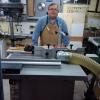
Originally Posted by
Jeff Heath

What's not to like about a Starrett #98 machinists level? They are cast iron, and NOT aluminum, for a really good reason. Aluminum moves way too much to be of any quality for a long period of time. There's a reason why all the top manufacturers of machinists levels, camelback straightedges, etc....are made from cast iron. As far as being easily broken, I don't even know what that means. If you drop or knock any precision measuring equipment, it's going to not service you well. Handle it properly, and then store it properly (mine came with a very nice wooden case, padded inside) and there's nothing to worry about regarding breakage.
Incidentally, I wasn't recommending dropping $300 on a new one. I see them for sale all the time around $100, and I guess I was lucky when I found my bigger one for $75. It has serviced me very well for a decade.
If you are worried about the cost, buy a used one, get your machine set up, and then sell it.
The desire to have quality equipment, but then resist the necessary tools to support the investment properly, is mind boggling to me. The time spent messing up quality timbers alone is reason enough, to me, to always buy the best tools I can, and make sure I have them set up properly, the first time. An annual maintenance schedule of checking all my tools, equipment, greasing bearings, wiping and cleaning up, a fine tooth brush on gears to remove gunk and grime, etc......takes one day a year, and is the very best investment I can ever make in my shop gear to ensure that I can continue to produce high quality work without having to continually trouble shoot problems with my tools. Invest in quality, and cry once. I applaud Mark's desire to fine tune his machines to their highest capabilities. You don't have to break the bank open to invest in quality used precision tools to support your gear. When suggestions for support equipment from horror freight and chinese military surplus get mentioned, my stomach begins to churn in a very uncomfortable way. That stuff is junk, and should be sent back where it came from.






 Reply With Quote
Reply With Quote

